Before it became the holiday that commemorated Americans who have defended their country in war, Memorial Day celebrated the end of the Civil War. It was felt by many of the former Confederate States that Memorial day was a Northern holiday that commemorated the North's victory in the Civil War and for many years Memorial Day was not celebrated in the South. Throughout the late nineteenth century and early twentieth century there were markedly different feelings about the Civil War, its causes and its aftermath. The philatelic fallout from this was the establishment of two national philatelic organizations-the American Philatelic Society and the Southern Philatelic Society. Both organizations were established in the 1880's and collectors who wanted to join philatelic organizations were never so plentiful that either stuck solely to its geographic roots. Members from all over were welcomed in both societies but the fact that there were parallel organizations was a hold over from the Civil
Monthly Archives: May 2011
- Posted May 31, 2011Read more »
- Posted May 27, 2011Read more »

One of the more interesting anomalies in philately is how some types of specialty items of some countries are very popular while the same type of specialty material for another country is ignored. Look at marginal inscriptions. Marginal inscription plate numbers of the United States are avidly collected as plate blocks. Marginal inscriptions are avidly collected in Israel as tabs and the British area as Traffic Light gutter pairs. But for UN nobody collects Mint Inscription blocks despite years of dealer hype about them. Proofs are another area where collectors show different preferences by area (Proofs are the first impressions of the plate taken for printing control purposes and sometimes issued to the collecting public or prominent officials). Proofs of British Commonwealth stamps are scarce and were not regularly issued. When offered they sell quickly and for a lot of money. Proofs of Latin American stamps are also scarce, typically existing in quantities of less than 200. But they - Posted May 26, 2011Read more »
Compared to the wedding of Prince William's parents, Charles and Diana, this month's Royal wedding has been philatelically unimportant. For the last wedding there was months of philatelic advertising and extraordinary pressure from telemarketers to get collectors and non collectors in on the philatelic event of the century. It turned out to be a true non event. British Omnibus issues commemorating Royal weddings and births and birthdays have languished with each new generation of collectors having little interest in the issues of the past. But William and Kate I think have a decent philatelic chance of having their wedding commemoratives achieve lasting popularity and higher prices. Here's why: First, this has been a minimally hyped philatelic event. In the Linns-Scott Stamp monthly of May 2011 there isn't a single advertisement for these stamps. And there are not quantities of these stamps being sold into non traditional markets by telemarketers either. Market overhang will be small and
- Posted May 25, 2011Read more »

Most philatelists soon exhaust the specialty that they have chosen. Virtually any country can be 95% completed for between a few hundred and a few thousand dollars. Most collectors never spend more than a hundred dollars for a single stamp and so the problem with our hobby is that collectors soon paint themselves into a corner and either move on to another country to specialize in or add covers or other specialty items to their collections. Another way to jazz up a collection for not a lot of money is to add nonphilatelic collateral items. Some collectors add maps or personal pictures relating to visits or to the stamps themselves. Some add autographs of famous people. Many autographs are quite modest in price and they can personalize a collection and add a great deal of interest to your hobby. Suppose you collect Vatican City stamps-a pretty nice specialty and quite manageable. Vatican City has issued a couple thousand stamps- all but about fifty of which should cost less than a thousand - Posted May 24, 2011Read more »
The market for modern United States stamps-those issued after 1960-remains weak. These stamps, both definitives and commemoratives, were issued in huge quantities and were saved by the millions by American collectors. They were saved for several reasons. First, the average face value was low and it was common to hear of collectors "putting away a few sheets" of each issue. Second, the United States had no tradition of demonetizing older postage stamps (as many European nations have done every few years) and so, in nominal terms at least, mint postage retained its value. And third, collectors who came of age after 1960 saw that collectors of the previous generations who had put away quantities of current issue postage stamps had made great profits. I remember buying sheets of Norse Americans(#620-621 ) from a collector in 1975 for $750 that he had paid $8.40 at the post office. Such stories make for hoarders. But for the last fifty years the story has been very different. Postage has performed
- Posted May 23, 2011Read more »

When the Nazis took power in Germany in 1933, it didn't take them long to completely alter the stamp issuing policy of the Wiemar Republic. Perhaps most illustrative of the change is the Wagner set issued within a few months of the Nazi takeover of the German government. Wiemar stamps are calm and placid with bucolic country scenes, nonpolitical German heroes and old rural castles. Richard Wagner, whose operas are illustrated on this early Nazi set, was a fiercely Germanic composer and antisemite. He was a bold tonal innovator in music and like Hitler, who felt that he was destined to lead, felt divinely inspired to change the future of music. The operas of Wagner are largely based on Germanic myths and portray the Germanic nation as different and chosen. Stamps are a wonderful way for a government to pound home its subliminal message.
The Nazis believed that Germans were genetically superior to other races and deserved to rule them. There was a strong militaristic quality - Posted May 20, 2011Read more »
There are three main conscious reasons why people collect anything and there are specific modifications of these principles about why they collect stamps in particular. First, collecting satisfies the desire to set and achieve goals. Stamp collecting is a particularly satisfying hobby in this regard in that, because of our extensive catalogs, collectors know what they need to obtain more clearly than most other collecting hobbies(try getting a complete collection of red buttons). If a collector sets a goal of obtaining a set of Famous Americans he can readily achieve it. Goals can be set at easy to very difficult levels depending on the collectors interests and needs. Second, collecting fulfills our need for orderliness. People have a need to arrange things in ways that make sense and in this regard, philately is one of the best hobbies as our albums and neat page lay out make ordering different pieces of paper easy and interesting. And third, people collect because of an aesthetic appreciation
- Posted May 19, 2011Read more »
The Post Office and stamps are again in the news this time bearing whether or not the health care bill (so called Obamacare) that Congress passed last year is constitutional or not. Much of this case centers around the "necessary and proper" clause and the commerce clause of the Constitution. The great Supreme Court case that decided that Congress had powers to further its role of governance that were not specifically enumerated in the Constitution was McCulloch v Maryland which was decided in 1819. In this case Chief Justice John Marshall (commemorated on US Scott #1050) and the court decided that it is ludicrous for the Constitution to give Congress a power or authority without the implied power to do what is necessary to carry this out. And here, in his decision John Marshall spoke of the Post Office saying that the Constitution specifically establishes the Federal governments right to open Post Offices and that without implied powers "Congress's power to establish post offices could
- Posted May 18, 2011Read more »

One of the most important philatelic events of the early Twentieth Century was the issuance of long definitive sets by major countries that continue in use over a period of many years. The United States issued the Washington-Franklin set and in various forms this set dominated our mail for over thirty years. The same was true of the Post Horn set of Norway and of the Sower set of France. Post Offices were not so obviously after collector money in those days and when they found a design that worked, they stuck with it. The reason that these sets are interesting to collectors today is that because they were in use for so many years hundreds of varieties exist. What is of even greater interest is that for the most part these varieties are not of the minor printing variety type but rather are varieties caused by printing evolution and differing postal needs over the years that the stamps were in use. On the Sowers you have the basic face different set issued over a period of nearly thirty years. - Posted May 17, 2011Read more »
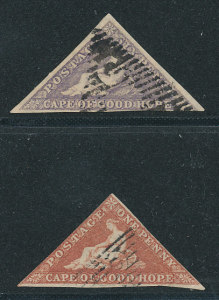
The two most Southern British areas of influence-Australia and South Africa- were also the latest to confederate and begin issuing postage stamps as a single geographic unit. South Africa confederated in 1910 and before that was made up of the Boer dominated Transvaal, Orange Free State, and Stellaland and British dominated Cape of Good Hope. In 1855, Cape of Good Hope became the first stamp issuing country to issue stamps that were not rectangular endearing itself to the first generation of collectors. The Cape was a thriving trading colony and postal communication was well used by the inhabitants. The triangular stamps of the Cape were always popular and sought after from the very earliest days of philately. But popularity in stamps not only requires that collectors want an item, it requires that there be enough of an item in philatelic hands that active trading can take place and collectors can afford to obtain them. In the 1890's a merchant ship arrived in London and a group of sailors - Posted May 16, 2011Read more »
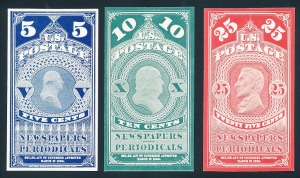
Special Service stamps tell you a lot about a country. How does a country view charity? If the feeling is that the government should encourage charitable contributions to specific causes then that country will issue a lot of Semipostal stamps. Larger countries with lots of distance between cities issued a lot of airmails and special deliveries. And the United States issued over 120 Newspaper Stamps, winning the race in this category by a factor of ten over runner up Austria. Most countries never issued Newspaper stamps. None of the British Commonwealth nations did, nor did the German or French Area. The reason for the vast number of US Newspaper stamps is due to both the geographical distances between areas in the United States and a commitment since Revolution days to political discourse. Freedom of the Press is the first of the freedoms in the Bill of Rights and throughout the nineteenth century congress felt that this meant not only freedom to publish but also ease of dissemination. - Posted May 12, 2011Read more »

The first of the famous three stamp triptych of the 1920s-the Pilgrim set of 1920-has its centenary in just a few years. These three sets- the Pilgrim set, the Huguenot-Walloon set and the Lexington-Concord set- defined the commemorative issues of the 1920's and as with most commemoratives displayed the self image that America wished to project at that time. The 1910-1924 period was a time of record immigration to America. But this immigration was politically contentious (just as today's is) and resulted in severe limitations of non-Western European immigration after 1924. It is odd that with the demographics of the United States changing by the immigration of millions of Eastern and Southern Europeans that the 1920 Pilgrim set would commemorate the few hundreds of early English descent. Political history and cultural anthropology as shown by postal issues is a new field and this early Pilgrim set in the midst of America's first great immigration fight is certainly interesting. As philatelists - Posted May 11, 2011Read more »
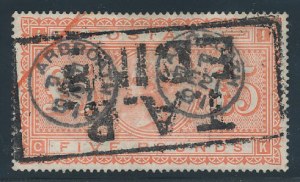
Prices and the value of money are difficult to evaluate over time. Readers of Victorian novels know that in the late Nineteenth Century an income of about 150 Pounds a year was the minimum needed to live as a gentleman (Trollope says tartly "an embarrassed gentleman, yes, but a gentleman"). That was three Pounds a week and for that a person could rent an apartment, eat and have a part time servant. Before 1900, prices for food and clothing were proportionately much more expensive and labor was proportionately far cheaper. Sir Walter Scott writes that in his time one could engage a servant for little more than food clothing and shelter. Still, if a middle class person could live a decent life at three Pounds a week in Victorian England and the Post Office issued a stamp for five Pounds it would be the equivalent in spending power to a $1000 stamp today. This raises the question of what could such stamps possibly be used for. Mainly they was used by banks that sent quantities of cash and - Posted May 10, 2011Read more »
The Philadelphia Stamp Show was held in Valley Forge, PA last month and it was a small shadow of its old self. Thirty or forty dealers plied their mostly tired wares and the exhibits looked like the same group that has been competing for gold since the California Gold Rush of '49. Every years shows get smaller and less significant (this year's Philadelphia show was situated in the same venue as the Philadelphia Hot Tub show). And its not just Philadelphia. All shows-both national and regional- are diminishing or disappearing and the trend seems to be accelerating. (The only exception are Internationals which come to the United States and Canada every ten years and are real events that should not be missed). And really why should anyone go to shows? The Internet offers a far vaster array of merchandise for sale than any show ever could. The rare stamps and covers and philatelic exhibits that are posted on the web contain the greatest rarities and exhibits that the world has ever known. It
- Posted May 09, 2011Read more »

The relationship between quality and price in our hobby is ever changing. Quality standards are constantly evolving and what people look for today is quite different from the quality standards of the early days of our hobby. The earliest generation of collectors were space fillers with little or no regard for quality. Early dealer price lists and ads prove this as usually the stamp number is listed with a price with no quality grade given. About 1910 standards changed and the most defective specimens began to be discarded. Dealers began to list stamps as "Poor-Fair-or Good" to distinguish three quality grades. Grade inflation ensued so by 1950 the grades were "Very Good, Fine and Very Fine" with the linguistic contradiction that "Very Good" came to mean not so very good at all. "Extremely Fine" and "Superb" were added in the last thirty years and lately numeric grades have been added for the finest specimens. Pricing between quality grades has changed even more dramatically. In the earliest - Posted May 07, 2011Read more »
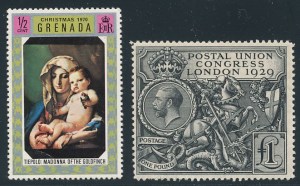
Perhaps the greatest change in our hobby in the last 80 years has been in the quality of the product that we collect. Stamps have gone from miniature pieces of art that reflect the skill and technological prowess of the nation that issued them to being little more than a chit indicating payment of postage, usually with a theme to appeal to collectors. The change is not only cultural-taste and artistic standards are lower now than they used to be- but also reflect the diminished roll that letters, and consequently postage stamps, play in our society. Until about 1950 telecommunication was difficult and expensive and was only used for the most important communications. Costs of telephone use has lowered dramatically so that today the largest cost to the telecom companies is not the lines or the satellites but the actual costs of billing customers. Today, most people pay a flat monthly fee for all their telecommunications with no distinction between local and long distance. Email is essentially - Posted May 06, 2011Read more »
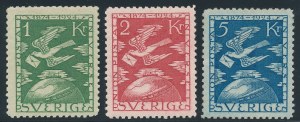
By 1874 the system of international carriage of letters was a mess. Countries had to negotiate postal treaties with each other and most treaties called for cross payments where part of the postage of a letter was remitted by the sending post office to the receiving post office. This was confusing and difficult to keep tabs of but of further complexity was the cross payments to transit countries (say when a letter from the United States landed in England, was sent to Poland and then across land to Russia). Nearly thirty five years after the Penny Black, with world commerce rising, the system of cross payments just wasn't working. It was slowing down communication and as postage rates dropped it was becoming more expensive to account for the letters than to carry them. In 1874 the United States proposed an international congress to discuss the problem and what emerged was an agreement for an organization that was one of the first international cooperation organizations (it was in fact the - Posted May 05, 2011Read more »
There are very few areas of philately that can't be specialized to the max. Take the early postage dues of Romania for instance. Most collectors have just a single example of each of these common stamps but they are known with many perf varieties and especially scarce compound perfs (perforated say 14 at side by 12 at top), some of which are very rare. To specialize in this kind of area one has to know that such varieties in fact exist and then have enough of the material to sift through so as to both find enough material to actually have a collection and also to feel satisfied that you have accomplished something as a collector. This is just an example. Such specialization exists, though, on hundreds of micro areas in our hobby. But for the most part it attracts only a few explorers. In all but a few areas, the vast majority of collectors are content to collect by the catalog and have mostly face different stamps. But there are a few areas of our hobby which collectors have super specialized.
- Posted May 04, 2011Read more »

Chile was one of the last South American countries to be colonized. With little gold or silver to exploit or passive Indians to enslave, the southwest coast of South America was not as attractive to the Spanish invaders as was the rest of the new world. Colonization came later when copper was found, and when the rich Mediterranean style climate showed that European type crops (and especially grapes) could be grown and when steam sailing ships and railroads could link the long narrow nation. Geographically, Chile is a narrow ribbon of a nation averaging 100 miles wide by 2700 mile long. The first stamps of Chile were issued in 1853 and were produced in London. The plates were transferred to Chile and over the next fifteen years numerous printings were made. With "a" numbers, Scott recognizes about sixty different printing, shade, watermark and color varieties putting the first issues of Chile in the same class as the classic Hermes Heads of Greece as among the most super specialized stamps - Posted May 03, 2011Read more »

Pakistan has been much in the news. Philatelically, Pakistan is a relatively new nation-state. The history of Pakistan is bound with the history of India and the relationship between those two countries is hostile. Separated religiously and culturally, under the British, Pakistan was not a separate nation at all but rather was part of India. India throughout it's history had endured numerous invasions from the East and North and many of these invaders had been Muslim. There has always been considerable antipathy between the Hindus and the Muslims and when India became independent in 1947 it was Gandhi's goal to maintain the Muslims and Hindus in one country. This proved impossible and India was partitioned with the Muslims moving both west and east forming the countries of East and West Pakistan (East Pakistan later obtained independence for itself and is now Bangladesh). Historians estimate that nearly one million people were killed during the Partition and many Hindus and Muslims had
